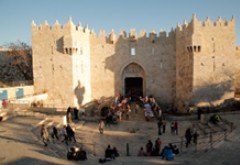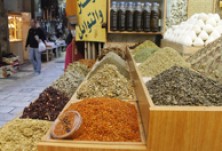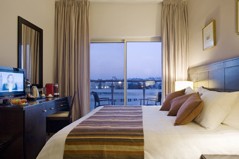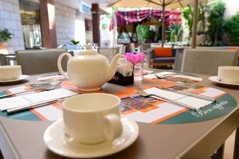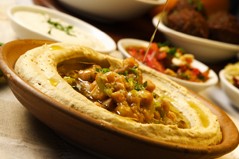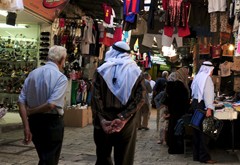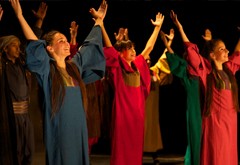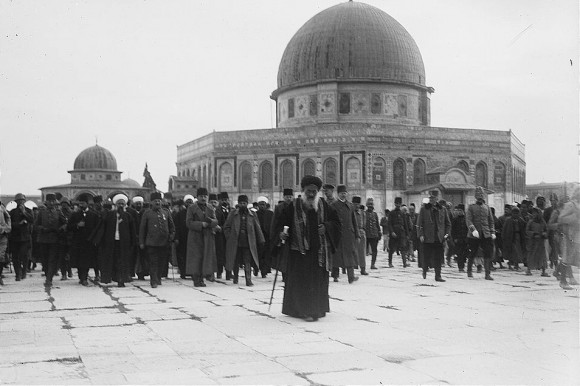Four years after Ottoman control of Jerusalem, Sultan Suleiman Al-Qanuni (the Lawgiver), son of Sultan Salim, conqueror of Jerusalem, accessed the throne in 1520. He set as his aim the upgrading of Jerusalem, thus starting the fourth stage of the city's golden history. The first project of the Sultan (ruled 1520 - 1566) was to restore the water system, build drinking water fountains, renovate Al-Haram Al-Sharif, and especially the Dome of the Rock, fortify the Citadel, and finally and most importantly, build walls to protect the city from western ambitions and Arab tribal attacks, after the Mamluks ignored this aspect for over two and a half centuries, unlike the Citadel, which witnessed extensive building and fortification activity during the Mamluk period.
The present walls of Jerusalem, and most of its gates used, are still without any virtual change, and carry the prints of the Sultan Soleiman Al-Qanuni. The project to build fortifications in the form of walls, towers, gates, and the Citadel took five years to complete (1536 - 1540). The wall comprises 34 fortified towers and is about 4 kilometers long, with an average height of 12 meters.
The Sultan's activity was not restricted to fortifications, but extended to building and restoring the system of city waterarriving from Al-Arroub area and Suleiman pools south of Bethlehem, known as Al-Sabeel Canal. He also built six drinking and ablution water fountains, five of which were inside the city, and the sixth outside it near the southwestern corner of the city wall, named SabeelBirket Al-Sultan (Fountain of the Sultan's Pool). All these fountains were built in 1536. He also restored and enlarged the Sultan's Pool. Al-Haram Al-Sharif witnessed a comprehensive restoration project, particularly for the Dome of the Rock, the walls of which were covered with China tiles and marble, replacing the mosaics. He also renewed three of its four doors, and covered the adjacent Al-Silsilah Dome with China tiles, and contributed to the renovation of Al-Aqsa Mosque.
His wife Roxlaneh, known as KhaskiSultan or Khurum, who was originally Russian (according to most reports), also contributed to building a great social institution (Tliyyeh), declaring it as a Waqf in 1551for the benefit of pilgrims, visiters, and the poor. It comprises a huge complex with a mosque, a hostel, a Ribat (Sufi sanctuary), a kitchen, a bakery, a drinking water fountain, and storerooms. It became the most important charitable organization in all of Palestine, supported by many villages and farms throughout Syria and Palestine. The sultan added to it many Waqfs after the death of his wife, and it still carries her name until now: "Khaski Sultan" or "Tkiyyeh," and is used as an Islamic orphanage and vocational and academic schools.
The description by the traveler OliaJalabi in his book "Siyahatnamah" in 1672 is the largest evidence of what Jerusalem became during the first stage of the Ottoman period, whereby he states that Jerusalem is a city which seems small, has 240 Mihrabs (praying niche), 7 houses for Hadith (Prophet Mohammad's sayings and actions), 10 houses for the Quran, and 40 schools and Tikiyyahs for seventy different methods for Sufism, the largest being the methods of Abdul Qadrer Al-Kilani (Al-Jilani), Ahmad Al-Badawi, Al-Rifa'ei, and Al-Mawlawi. It has 6 Khans (hostels), 6 bath houses, 16 Sabils (drinking water fountain), and 2045 trading stores, as well as numerous Souqs (markets). There are two churches for Armenians, three for the Roman Orthodox sect, and two synagogues. There are, in total, one thousand opulent palaces which look like castles.
The interest in Jerusalem is evidently clear (the Noble Holy City, as the Ottomans called it). Suleiman Al-Qanuni's measures to re-launch trade, visitation, and pilgrimage to Jerusalem succeeded, and the city was once more transformed to the beginning of a golden age, and this reflected on the population which increased many times over in the sixteenth century.
The beginning of the Ottomans in Jerusalem was great with its achievements,yet as the end of the seventeenth century approached (the Treaty of Karlowitz), it started to recede as a result of the state being busy in the emerging Europe, the erosion of the governance system, the decrease in revenues from Awqaf, the increase in the inflation rate, and the loss of control over the Inkisharis. Hence, the Ottoman Empire could not maintain the level of services provided to the residents and visitors, and the assaults by Bedouintribes. Most schools and establishments collapsed, in spite of the fact that the Sufi movement and its Zawias continued to prosper. In spite of all this, the Ottoman attention to the holy places continued, and the buildings of Al-Haram Al-Sharif enjoyed clear attention throughout the Ottoman period.
Among the signs that can be referred to in the seventeenth century, which continued to grow later on, is the interference of western consuls in the affairs of Jerusalem, particularly in issues related to struggle among different sects over the holy places of the city, which, in many cases, promoted prejudices to create justification for interference, and to prove the Ottoman Empire's inability to govern the holy places.
The eighteenth century started with a revolution in 1703, led by the "commissioner of the noble citizens", Mohammad Ben Mustafa Al-Husseini, and continued for two years, expressing the deterioration of public affairs and a clear erosion of the state's central authority, as well as a significant growth in the power of local clans. The ruler of Jerusalem, Jorbaji Mohammad Pasha, imposed exorbitant taxes on the residents of Jerusalem and the peasants in the area, using oppressive measures to collect them, including the detention of large numbers of Jerusalem residents. The revolution broke out, controlling the city and releasing the detainees. Jorbaji ran away, was appointed ruler of Damascus, and sent a large force of Inkisharis to suppress the rebellion of Jerusalem in 1705. The commissioner of the noble families ran away to Tartus, where he was apprehended, sent to Istanbul, and executed in 1707. Many times, the residents of Jerusalem had to declare disobedience against the Ottoman Empire, either to protest the misbehavior of rulers and employees, or to express condemnation of the exorbitant taxes imposed on them.
Jerusalem in the 18th century was basically governed by the notable families of Palestine, such as the Touqans and the Nimrs in Nablus, and Jerusalem families, such as the Husseinis, the Khalidis, and the AbiAllutufs, who became more powerful, and the Ottoman Empire's dependence on them to manage public affairs increased with time.
By the middle of the 19th century, Ibrahim Pasha, son of Mohammad Ali Al-Kabir of Egypt, arrived at the city walls in 1831, defying the authority of the Ottomans and the countries of the west, as part of a campaign that covered all of Bilad Al-Sham. Although Ibrahim Pasha attempted to reform the prevailing system, local rural powers resisted him vigorously, starting in 183. Furthermore, his campaign opened the eyes of Europe on Palestine in general, resulting in consolidating Palestine, particularly Jerusalem, increasingly within the global economy system. Under pressure from international powers, Mohammad Ali Al-Kabir had to withdraw his forces from Bilad Al-Sham in 1840, restricting his control to Egypt.
Ibrahim Pasha contributed to implementing many administrative reforms in the city, and built a headquarters for governance called the Kishlak, which is still standing next to the Citadel. Jerusalem's openness to the world during the rule of Ibrahim Pasha affected Jerusalem strategically, by form or demography. There is sufficient scope to believe that Ibrahim Pasha's measures led to direct European intervention in the city, which led to the widespread Jewish immigration to the city. In any case, these measures contributed to Jerusalem enhancing its relations with the outside world in a noticeable manner. It is also possible to notice an unprecedented increase in ethnic and religious multiculturalism in the city.
Jerusalem managed, during the 19th century to grow at a pace that is not consistent with its location. This century witnessed a clear growth in coastal cities such as Jaffa and Haifa, in line with the growth in other Mediterranean cities like Alexandria and Beirut, for example. Hence, it is possible to consider the growth in Jerusalem as outside the general framework, since it does not enjoy any commercial or strategic position. Its religious and political importance, however, became a pressure factor towards development. Jerusalem became, in 1872, the undisputed capital of Palestine. Yet this Ottoman administrative measure was immediately cancelled due to European celebrations of this development, which was compatible with European aspirations. The Ottoman Empire sensed the danger, but Jerusalem continued to be the de facto capital of Palestine, regardless of any administrative measures to the contrary.
East and West in Jerusalem
Large numbers of European travelers arrived in Jerusalem during the second half of the 19th century. They immortalized their adventures by writings they published, which included detailed descriptions of the city's conditions, as well as valuable notes. In reality, it is rather difficult to write the history of Jerusalem in this century without relying on this travel literature, although most of it was written for the purpose of rationalizing the cultural and religious superiority, and later on, European colonialism, and contained numerous clear and implied invitations to the effect that the "barbarians of the orient" do not deserve this great city.
In any case, European powers became aware of the potentials for entering Jerusalem, not only because of the Ottoman Empire's weakness, but also out of fear from each other and fear for its interests. Most states hurriedly opened consular representation offices in the city, with Britain starting the trend in 1838, followed by Prussia in 1842, Sardinia in 1843, France in 1843, Austria in 1847, Spain in 1854, the United States in 1856, and Russia in 1857. The Consular representation was accompanied by missionaries, particularly by the Latin Patriarchy, which renewed its activities in the holy land in 1847, after it ended with the Crusades. It had been preceded by the Protestant Church, which established a joint parish between Britain and Prussia.
It is noteworthy that the Roman Orthodox patriarchs moved their headquarters from Constantinople to Jerusalem in 1845. In 1848, a Protestant church was inaugurated (Christ Church) near the Citadel. After its success in the Crimean war, Russia assumed a special role in the holy land, and a Russian Bishop arrived, accompanied by a Consul, and started to build in numerous locations in and around Jerusalem. Their buildings were referred to as "Mascobiat" (Moscovites), with a large compound built to the northwest of the Old City. In general, it can be said that after the Ibrahim Pasha campaign, Jerusalem became a center for sweeping European competitions as part of the "Eastern Question."
Hence, Jerusalem entered the era of European architecture after a break that continued for about seven centuries, with the end of the Crusader era, represented by western style buildings in the city, as churches, convents, schools, hostels and hospitals. They changed the city style and filled the gaps generated by a series of earthquakes, particularly those that hit the city in the 17th and 18th centuries. Some old buildings were also demolished and new huge ones were built in their place.
Western development was initially concentrated inside the inside the Old City along the Via Dolorosa, starting with the St. Anne Church and compound, along Al-Wad street, and towards Aqabat Al-Mufti, ending at the Church of the Holy Sepulcher, especially SouqAftimos, the German Lutheran Church of the Savior, and Alexander Nevski Russian hostel. The development activity expended to include most of the area between Jaffa Gate and the New Gate.
Construction development started inside and outside the Old City of Jerusalem in earnest after the Crimean war in 1856. Towards the end of the 19th century, 42 convents, 28 hostels, 17 hospitals, and 54 schools (including eight Rashadi schools) were counted. Among these institutions was the Schneller School (the Syrian Orphanage) in 1860, TalitaQumi School in 1868, the French Fraire school in 1876, and the White Fathers' School (St. Anne Convent) in 1887.
During this period, the sewage network was completed inside the city walls in 1868, after completing tiling all the Old City streets between 1864 and 1865, as well as installing water pipes. In 1858, all buildings were numbered in large Arabic numerals, and the city municipality was established in 1863. The slaughterhouse and tanneries were moved outside the city walls in1880, and the streets were installed with a lighting system in 1896, using kerosene lamps, with a decision from theMunicipal Council. The lighting process continued for a number of year, and by the beginning of the 20th century, all the city was lit and its streets were clean, with the municipality organizing a campaign to regulate waste disposal outside the city and to carry out regular periodic cleaning efforts. Around 1880, the municipality installed clocks in public squares.
A telegraph and postal service were established in the city in1876 in SwaiqetAlloun, and a center for the Austrian postal service opened in 1859 in the Armenian Quarter, the postal service gradually became an Austrian (Hapsburg) monopoly. In 1900, Germany inaugurated its postal service in Jerusalem, taking the service more seriously than Austria, and installing mail boxes in all the streets of Jerusalem, with the German flag engraved on all boxes. The visit by the German Emperor Wilhelm II in 1898 left many German flags and eagles around the city. A few months later, France joined the fray and inaugurated its own postal service, competing with its European neighbors, being the protector of Catholicism in the Holy Land and the sick empire. As for Russia, the protector of the Orthodox sect in Jerusalem and the Ottoman Empire, it reacted immediately, inaugurating its postal system in 1901. The Italian response to this provocation was late, and Italy did not enter the competition in Jerusalem until 1907.
The municipality had taken a decision back in 1868 to build a series of public toilettes to serve the city visitors, pilgrims, and markets, and these facilities continue to be use until present.
In 1885, the old stone tiles in the alleys of the Old City were replaced with new ones, and rainwater gutters were built along the sides of the streets. The new tiles continued to be used until the 1960's, when they were either covered with asphalt or reinforced concrete, or removed after the Israeli occupation.
An important part of the building and expansion movement took place outside the city walls, practically rendering the function of the walls and the gatesobsolete. Gates ceased to be closed with the beginning of the 1870's, and new neighborhoods outside the wall from the east and west started to attract modern life and commerce. Paving the carriage road between Jaffa and Jerusalem in 1868 helped the emergence of new architectural styles, as the result of easier transport of building materials, particularly steel beams and wooden planks from the active Jaffa port to the expanding city. In 1864, Jerusalem was connected by telegraph with Jaffa, Constantinople, and Cairo. The project to connect Jerusalem to the world was completed with the Jaffa - Jerusalem railroad line in 1892, followed by the introduction of telephone service in 1905, and the entry of motor vehicles in 1908. The first airplane landed in the city in 1912. A modern European-style city blossomed gradually in Jerusalem.
As new neighborhood appeared outside the Old City, Western building activity also flourished, starting with the areas surrounding the Old City and expanding to the Mount of Olives and the German Colony (1873), the Greek Colony, and other hilltops around the city.
The Zionist movement also became active in the city by increasing the number of Jews and expanding the settlement movement both inside and outside the city walls. It was possible to see the building activities of Jewish institutions, such as the Lemelschool in 1868, the Evelinade Rothschild School for Girls in 1864, and the Israeli Union School in 1881. Jewish residential neighborhoods also appeared to the northwest and along the sides of Jaffa Street. Huge connected buildings extending in a linear fashion also appeared, reminiscent of military barracks (Yemin Moshe, for example). This style started to appear clearly in the 1870s.
The architectural style in west Jerusalem was exceptionally large in size and higher than average traditional old buildings there, using modern western building technologies and materials. It was also characterized by prior planning by experienced western engineers, who did not overlook, in most cases, to consolidate oriental ornamental and engineering elements, inspired by the rich architectural heritage of Jerusalem, producing a cultural mixture which leaned towards the western style prevailing in Europe in the 19th and beginning of the 20th centuries. Some buildings showed a clear derivation from the crusader style, including their romantic and gothic styles, albeit with a modern formation, thus searching for cultural roots to establish a "legitimacy of presence" (Lutheran Church of the Savior, for example). This is perhaps a simulation and reminder of a religious and political reminder of this period, being an extension of that period (the Augusta Victoria).

